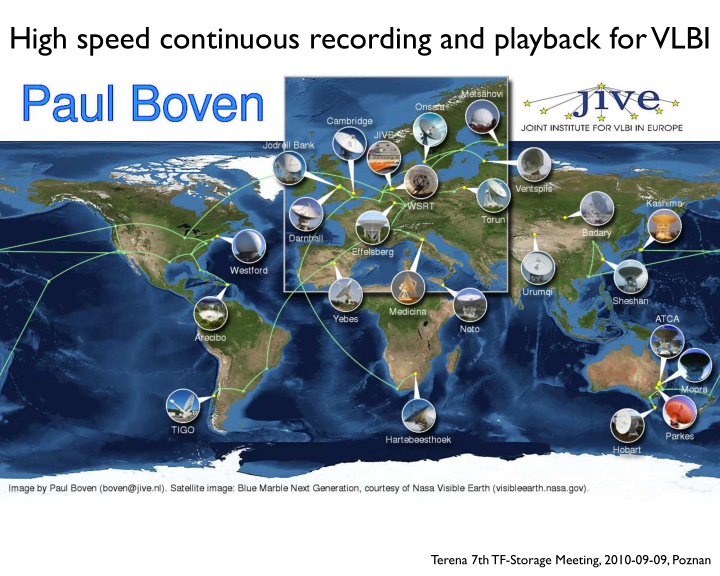



High speed continuous recording and playback for VLBI Terena 7th TF-Storage Meeting, 2010-09-09, Poznan
What is JIVE? Operate the EVN correlator and support astronomers doing VLBI. A collaboration of the major radio- astronomical research facilities in Europe, China and South Africa NEXPReS is a three-year project aimed at further developing e-VLBI services of the EVN with the goal of incorporating e- VLBI into every astronomical EVN observation.
Radio Astronomy Courtesy of NRAO
Radio vs. Optical astronomy The imaging accuracy (resolution) of a telescope: θ ≈ 1.2 λ /D ( λ = wavelength, D = diameter) Hubble Space Telescope: λ ≈ 600nm (visible light) D = 2.4m θ = 0.06 arcsecond Onsola Space Observatory: λ = 6cm (5GHz) D = 25m θ = 600 arcseconds Wanted: 240km dish
Very Long Baseline Interferometry • Create a huge radio telescope by using telescopes in different locations around the world at the same time • Resolution depends on distance between dishes and observing wavelength, milli-arc second level • Sensitivity on dish area, time and bandwidth • Requires atomic clock stability for timing • Processed in a special purpose super-computer: Correlator, 16x 1024Mb/s
Very Long Baseline Interferometry • Uses special purpose recording machines (Mark5) • And special purpose packs with 8 harddisks • Each telescope records at up to 1024 Mb/s • 5 TB in a typical 12h observing run • After correlation, the resulting dataset is a few GB
Our current Storage System... • Generally 3 EVN sessions per year, 3-4 weeks each • The total EVN storage pool is 1.7 PB • Which is constantly on the move
Very Long Baseline Interferometry • Initially (1990) we used large single-reel tapes • Then came harddisk-packs tekst tekst • And now: e-VLBI
Very Long Baseline Interferometry Latency: 2 weeks Latency: 150 ms “Never underestimate the bandwidth of a station wagon laden with computer tapes hurtling down the highway” (Andy Tanenbaum)
Why e-VLBI • Quick turn-around • Rapid response • Check data as it comes in, not weeks later (You can’t redo just 1 telescope) • Logistics (disks delayed/deleted/damaged/destroyed) Example: Cyg X-3 • Star + black hole • Flares irregularly • Timescale: days • Left: 2 weeks late • May: Observed flare with e-VLBI
Last night’s e-VLBI Obsevation of V407cyg nova outburst
Disk VLBI vs. e-VLBI Disk VLBI e-VLBI Full bandwidth at each station Some stations have limited connectivity Shipping takes weeks Continuous, real-time quality checks Limited by diskpool size Data never hits disk - no reruns Broken harddisks, recording problems Broken fibers, router problems Long scheduling due to logistics Target-of-Opportunity observations Better sensitivity Better reliability : best of both worlds
The NEXPReS project • Recording at the telescope • Real-time transfer and recording at correlator • Use Bandwidth-on-Demand paths for transfer • Real-time correlation and quality monitoring • Best of both worlds: highest reliability and bandwidth • Shipping as much data over the network as possible • Higher speeds: 8 Gb/s per station, and beyond • Storage challenge: continuous recording at 8 Gb/s with real-time replication and simultaneous playback
The NEXPReS project • Is an Integrated Infrastructure Initiative (I3) • Funded under the EU Seventh Framework Programme • 15 Astronomical Institutions and NRENs participating • 4 main workpackages: • WP5: ‘Cloud’ correlation • WP6: High Bandwidth on Demand • WP7: Computing in a shared infrastructure • WP8: Provisioning High Bandwidth, High Capacity Storage on demand
WP8: Provisioning High Bandwidth, High Capacity Storage on demand • A distributed on-demand storage system: • Record at telescope • Best-effort real-time transfer • Record at correlator • Rerun once all data is complete • Multi Gb/s read/write performance • Research hardware, software, raids Metsähovi Observatory • Use for Scientific Archives (LOFAR) • WP coordinated by AALTO (Metsähovi, Finland)
The future of the EVN • More telescopes to join • New correlator based on FPGAs (UniBoard) • Higher observing bandwidths (4Gb/s, 8 Gb/s, ... ) • NEXPReS: combined real-time and disk-based VLBI Uniboard New telescope in Sardinia
Questions?
Recommend
More recommend